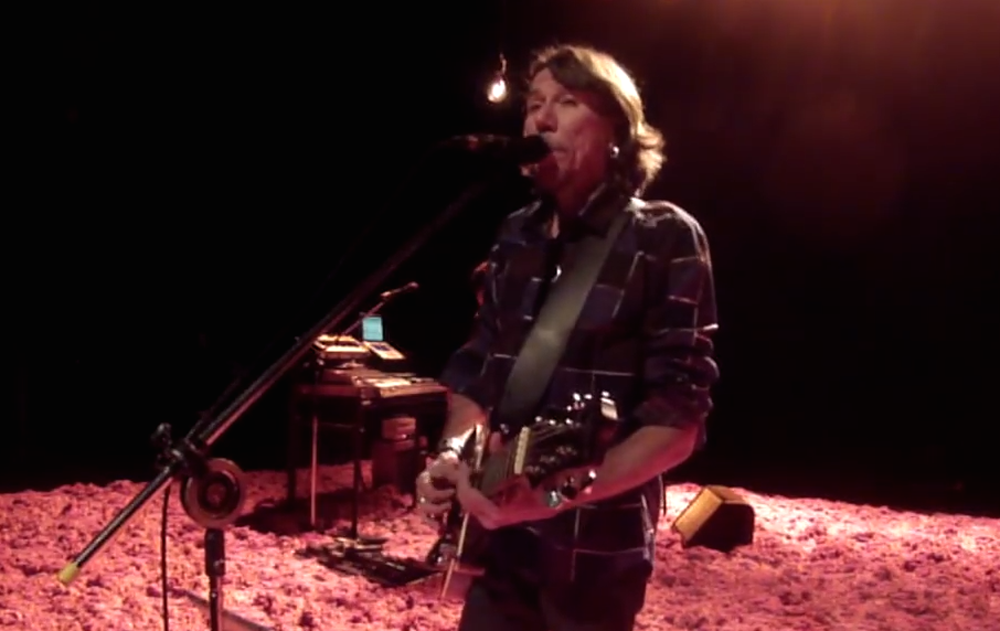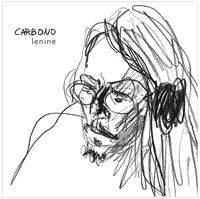 |
I spend way too much time hanging out on Facebook, following links to online articles and being amused by my friends' posts and photos. (I guess that's a tribute to the rich lives of my friends.) One of the musicians I follow is Brasilian songwriter Lenine, and recently he announced a live show which would be broadcast on line. He was backed by members of Nação Zumbi (who accompany him on "Cupim de Ferro" on this new album), and the show was superb. Nação Zumbi were the backing band for Chico Science who died tragically but the group overcame the difficulty of losing their leader to carry on (reminiscent of Joy Division's similar metamorphosis), however now in Lenine they've found a great poet to back up. For once the audience was not singing along (they didn't know the songs yet!) and the whole thing went off fabulously. And here's an album of all-new material from the great man. It's less than 40 minutes but some artists realize you don't need to pad out an album to an hour or 70 minutes just because that's the length of Beethoven's Ninth Symphony. It's mostly three-minute songs which are succinct and change it up frequently. You can sample his albums on his web page. The new album is less experimental than Triz and its predecessor Chão, and more straightforward hard driving songs with guitar and drum backing, or ballads with acoustic guitar and slight touches of effects. But there's still room for experiment. The song "À Meia Noite dos Tambores Silenciosos" is basically a poetry recital backed by a full orchestra (Orkestra Rumpilezz) with added horns and five drummers. You can hear a rehearsal here. The poem (translated as "At midnight of the silent drums") is a meditation on the ocean, with Olorum and Saint Joseph invoked in the overwhelming vastness. Another lush arrangement graces "O Universo na Cabeça do Alfinete (The Universe on the head of a pin)," which is another meditation on cosmic matters. This was recorded in Holland with a pick-up orchestra of European musicians. This leads us into a gritty outro called "Undo" with a lot of fuzz tone and thrashing drumkit, two minutes of static so we won't think he is going out quietly.
|
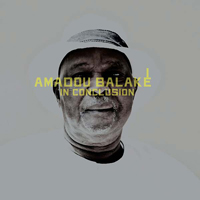
|
When "Bar Konon Mousso Bar" burst out of the frayed 16-inch speakers of clubs back in 1978 we knew there was a new rawer sound breaking out from the heart of Africa. Along with "Yeye Mousso" by Mali's Moussa Doumbia we were hearing the birth of Afro-Funk. We immediately said, here's the link to James Brown, though it had been erupting all over Africa long before James Brown hit Zaire in 1974. But in the West Amadou Balaké remained a fringe performer despite what in retrospect would seem to be major inroads. Balaké was born in Burkina Faso (when it was known as Upper Volta) where he grew up performing in local Ougadougan bands like the 5 Consuls and Orchestre Super Volta. He then launched his own group called Amadou et ses Dieux (they recorded on Club Voltaïque du Disque in 1976; the album was recorded in Accra, Ghana and pressed in Benin because of the lack of local facilities). He was a hit maker in West Africa, adapting Afro-Cuban and funk that were growing in popularity. He made recordings for the Sacodis label of Aboudou Lassissi in New York and had moved to Paris by the mid-80s. He returned to Africa to continue a fruitful career and scored more hits, before ending his career in style with Africando. That group was inspired by some of his own studio work (for Lassissi) three decades earlier. Now in retrospect we assemble the pieces of this majestic oeuvre. Pioneering publisher Günter Gretz put together Balaké's West African hits that appeared on two Lassissi albums, "Taximen" and "Vol 3" in Abidjan in 1978-9 as Taximen. They were actually recorded in Nigeria. Other early recordings from the 70s from Super Volta and the Five Consuls were included on the excellent Ouga Affair CD (Savannahphone 2009); more 70s recordings were unearthed by Samy Ben Redjeb and included on Bambara Mystic Soul (Analog Africa 2011). In 2008 Oriki music issued Señor Eclectico, a fine compilation of later 70s tracks including some of the Afro-charanga material from New York. In my passion for Lassissi productions I was able to find those discs, though I still cant find a label interested in getting the rights and doing a proper series of Lassissi reissues. Balaké moved fluidly between salsa, Afrobeat and the warba style of his native land. Inducted at last into Africando in 2000, he recorded three albums with them. Here, as a coda to his career, Balaké returns to the studio, this time with a group of young talents from his hometown, and does a mixed set of new and old material, but calmed down and utilizing more traditional instruments. He is in fine voice, the band is tight. These were his last recordings and are a fitting capper to a distinguished career. He died at the end of August 2014, aged 70.
|
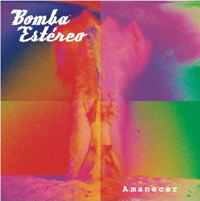 | BOMBA ESTEREO
AMANECER (Bigdeal Sony Latin Records)
In their career Bomba Estereo have covered a lot of ground, adding electronic beats to various folk styles and suggesting everything from Berber music around a crackling fire to wacky Rajasthani puppet shows with whistling accompaniment. Their solid rhythm-machine tracks are augmented by live drums, then guitar and synth back engaging lyrics: this has endeared them to clubbers worldwide. Some questions arise with the new Bomba Estereo album. First, going back to their emergence in the early oughts, did their name and sound come from Azul Azul's hit "Bomba" which swept Latino America in the late 90s? They have been touring incessantly since their third album, Elegancia Tropical (maybe since their first album in 2007!), so when did they write this material? On stage, or in hotel rooms? Singer Li Saumet was living in New York last I read so how did they rehearse? Upside to Sony deal: this should break them worldwide; downside: no lossless downloads. Their familiar techno-folk cumbia-flavored sound has given way to super pop, or Uber-pop with confessional, existential lyrics and angst-tinged delivery from Li (as in "Alma y cuerpo" and "Feeling" on their earlier albums). Sony sent them a gringo pop/electronica producer wrapped in gringo dolares rather than, say, a reggaeton producer, and obviously that impacted the end product. He had never worked with Afro-Colombian musicians before, so be ready for a different experience. More money, bigger exposure doesn't necessarily mean better product. Their spring hit, "Que bonito" is not on here. But their latest smash hit, "Fiesta" is definitely here. They cleverly put it in the middle of the disc. If they had led off with it you'd have said it was downhill from there. Instead they come out strong with a rap, and shades of Dazz and Gap Band in the squinchy synth. Li sings in Spanglish; I assume she writes some of the lyrics, sexy Spanglish lyrics from a woman's perspective, like (in "Caderas"), "Come on take me on the table como me gusta me." Those first two songs are just samples of their "electronic-folk" style, then they go for the sky-guitar-on-echo for "Somos Dos," the first song with a melody (as opposed to a declamation over a heavy beat). It's still built on a solid rhythm track. "Soy yo," with its flute & swanee whistle chorus is irritating in its way. I can't wait for it to be over because up next is "Fiesta." There's a 24-bar intro then all hell breaks loose with the bass synthesizer, rocking like a giddy inebriate on a rollercoaster. The only possible response is to turn it up, and take out any loose teeth you may have or they will rattle. Another ballad, the heartfelt "Algo esta cambiando (Something is changing)" makes another auditory break and shows them to be more than a mere party band. "To my love" is another upbeat song made melancholy with a whistling chorus. Tragedies in Li's personal life seem to have made her more introspective as a writer, though I think Simon Mejia is the musical mastermind. The bass subwoofer gets another workout on "Solo tu." The last song slows the tempo to go out on a mellow note. Amancer will undoubtedly win Bomba Estereo new fans and then those fans will be thrilled to discover their three previous albums.
|
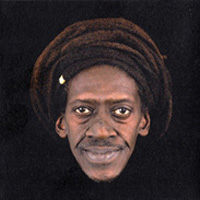
|
CHEIKH LO
BALBALOU (Chapter Two/Wagram 3322982)
I am trying to figure something out about aging and art. I suppose it should be self-evident that artists who are firey in their youth get mellower with age. We saw it with Baaba Maal and now the great Cheikh Lô (who has just turned 60) has created an album which has flashes of his old intensity, and is produced to the highest level, but is largely easy listening. On the other hand, with age comes wisdom so a stronger distillation of an artist's early essence may become more evident. This new album from Cheikh Lô, his fifth, was recorded in Stockholm. He set the bar high with his 1999 album Bambay Gueej on the World Circuit label. That disc crackled with energy and had an all-star line-up on it, grooving from salsa mbalax to funk and soul. There were Thierno Kouyate (Baobab, Ouza) on sax and Pee Wee Ellis (James Brown, Van Morrison) on horns and arrangements, Richard Egües (Orquesta Aragón) played flute, Oumar Sow (from Super Diamono, Ouza, and Youssou's band) played guitar and other Senegalese & Malian luminaries were present. Lô puts out an album every five years, so it's safe to say he is not a trend follower, he just moves along at his own pace making great songs. He usually includes a telling cover song, such as Bembeya's "Doni Doni" on Jamm. His big influence as a young man was Cuban music but he hangs out with Youssou Ndour and Oumou Sangare, so traditional West African music is more evident in his current work. In actuality however there are only light touches of kora and sabar: it's mostly keyboards and horns with a lot of guitar. Lô is Burkinabe, born to Malian parents, but gravitated to the music scene in Senegal where he became a member of the Baye Fall brotherhood, a Sufi sect who are partly responsible for Senegal remaining a calm place. The album starts with his strongest card: a song about Amadou Bamba, founder of the Mouride Brotherhood. The mellow quotient is signaled by a track with accordion and Flavia Coelho singing, and the predominance of ballads. "Leer Gui Fall" is another religious praise song, with a big horn section and pedal steel guitar. Even a song about revolution is laid back. He often resorts to falsetto so his voice floats off between the synthesized strings and acoustic guitars. Things spark up in the middle with a cover of Sam Mangwana's "Suzanah Coulibaly," sung in French. It's a sad song about a faithless woman but shows the pan-African reach of Mangwana's influence. Then "Balbalou" features Ibrahim Malouf on trumpet. It's a sonically engaging fable in a fine arrangement. And we drift off gently into the night.
|
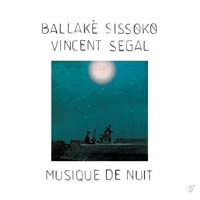 | BALLAKE SISSOKO & VINCENT SEGAL
MUSIQUE DE NUIT (Six Degrees)
This is only the second collaboration between these two: the producer Ségal who plays cello and legendary Malian kora player Ballaké Sissoko. It's another mellow outing with the two instruments perfectly complementing one another. The first half of the album was recorded live on Sissoko's roof, then a few days later they went into the studio to wax the rest. There is a lot of understanding in the give and take between them: tempo changes are surprising but only to us. It's been six years since their previous duets on Chamber Music. But we should count their appearance on Kasse Mady Diabaté's Kirike as another encounter, and Ségal also showed up on Sissoko's solo album At Peace. Between times he has also added his cello to recordings by Elvis Costello, Sting, Cesaria Evora, and Carlinhos Brown. Sissoko has worked with Toumani Diabaté, Taj Mahal, Rokia Traoré, and others. After years of touring the previous, very successful album, their collaborations have gained in strength: there are no other instruments but in the ambient night sounds you begin to imagine birds (maybe that owl hoot is real), flutes and other strings. Both are classically trained, Ségal brings Bach's baroque chamber confidence as well as jazzy bass-plucking chops and when he drops to bowed continuo, Sissoko knows where to bring the fire. Babani Kone sings on one track, though I would not have minded if they had left it entirely instrumental. You would not expect Bamako to be this quiet at night, but maybe the magical lullaby worked to lull everyone into a happy dream.
|
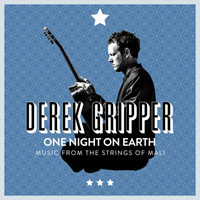 | DEREK GRIPPER
ONE NIGHT ON EARTH (Matsuli Music)
This is rather mindblowing. Look at the cover: there's a white guy pondering a six-string guitar (count the tuning pegs, there are six). Now listen to it -- there's a sample on the Matsuli page. What do you hear? Why, the familiar plangent tones of a kora! The kora has twenty-one strings and is played with both hands, thumb and index finger plucking out patterns that create polyrhythmic runs, not unlike a thumb piano. The music is not written down but passed on from generation to generation in the griot families of West Africa. What Derek Gripper has done -- and it is really amazing -- is figure out how to get the same sound out of a six-string guitar and by jove he pulls it off with aplomb. Gripper hails from South Africa and has explored a lot of different world music in his twenty years as a guitarist, including Indian and European classical music and pop styles from Cape Town and Brasil. Here he takes some compositions by Toumani Diabaté and rips through them in one long session (hence the title). The production preserves the atmosphere. Gripper tried transcribing parts of the music from Toumani's albums then decided he needed to improvise himself, to connect the dots. Each time he played he found new directions in the music and was able to create his own interpretations of the pieces instead of just mimicking the originals. Toumani himself is a major figure in world music. From a long line of griots, he recorded the first solo kora album in 1970 and at the time critics compared him to Segovia. Like Ravi Shankar he never repeats himself, but creates endless variations on every traditional piece he performs. When the composer heard these recordings in a radio interview he asked the DJ Lucy Duran to confirm she had seen the player do this on just one guitar. What Gripper discovered in transcribing Diabaté's performances was that the counterpoint of harmonic movement over a fixed bass pattern created the illusion of multiple voices and, like Bach's fugues, the melodic ideas swing against the structure, coming in the offbeat to give the impression of total fluidity. We are fortunate that Bach had the mathematical genius to transcribe what he was doing, but when he was just jamming up in the organ loft there is no doubt he was playing jazz. Years of practice and a true musical gift give some rare individuals the ability to transform this mechanical process into magic and Gripper's tribute to Diabaté certainly reaches that level.
|
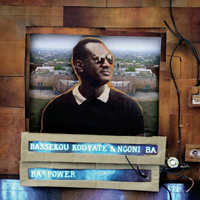 | BASSEKOU KOUYATE & NGONI BA
BA POWER (glitterbeat)
This is fantastic, a massive line-up of talented ngoni players who hit the ground running and don't let up. Kouyaté has added even more ngonis, it seems, to his band so it is like a whole orchestra of them in all shapes and sizes -- five of them (lead, three medium and bass) with an added guest kamale ngoni on four cuts. Kouyaté's wife, Amy Sacko, sings lead and backing vocals and there is a roster of additional guests including fab muted trumpet on the second track played by David Jahr. This is the group's fourth album and they started well and got better as they have grown in confidence. Despite the intensity, there is still air in the sound so you can hear the percussion and little touches like the slide guitar on track 3, which is a ghostly whisper in the background behind the array of plinked ngonis. The tempos change and you even get a suggestion of a Bach fugue on track 6, "Waati." I swear I hear electric guitar all over this album, though there's only a couple of guests listed on individual tracks such as when Samba Touré adds electric guitar on "Fama magni." So I guess it's Bassekou using an effects pedal to blaze Hendrix-like on the proceedings. Touré is on the same label and so, oddly are Eno and Hassell. Hassell adds keyboard and trumpet in a couple of places. There's also the soku, or horsehair fiddle of Zoumana Tereta who pops up in all the right places, or albums. This is a great set. I didn't want it to end, but finally they bring it down to a slow number and go out on tiptoes.
|
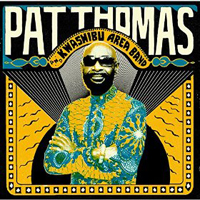 | PAT THOMAS & KWASHIBU AREA BAND
S/T (Strut Records)
One problem I have with modern Afrobeat bands is the simulacrum of the music they represent. I went to an African show in SF once and as an opening act they put on a Senegalese dance troupe from UC Berkeley. Bare breasted guys played drums while a dozen gorgeous mainly blonde 20-year-old girls pranced about in next to nothing. The crowd, you can imagine, went nuts. The "Problem" -- if for a moment you can conceive of there being any problem in this scenario -- was that their instructor had left Senegal more than a decade ago and what they were doing was a historical routine that had ceased to evolve. It was a valid performance but wasn't grounded in any current reality, and this is my problem with bands that sound like Fela Kuti: it's a 70s Lagos sound, not objectionable but no different in its way from the scores of African reggae bands that sound like Peter Tosh from the same era. You can listen to a Fela album and imitate the choppy guitar, any sax player can produce a credible Fela-sounding solo, and a talented drummer can anatomize the structure, but it is only a superficial resemblance and unlikely to go anywhere unexpected. It is not a living part of your experience, only a recreation of someone else's reality. But Fela and a lot of the other pioneers of Afrobeat and Highlife are dead. Not so singer and bandleader Pat Thomas. He moved to Germany in the 80s and with George Darko created a new type of music known as Burger Highlife, which had elements of disco (& is as dated as it sounds). Now, after 50 years in the business, Pat Thomas has returned to Ghana to wax some tracks: old favorites with old pals. He started out in the Broadway Dance Band and the Stargazers in the 1960s (singing often in English), alongside Ebo Taylor, who has also emerged from retirement to critical acclaim from a younger generation. Thomas was prolific in the 80s, touring Europe and the USA. The drummer from Fela's band, Tony Allen, also pops up on a couple of tracks to add his unmistakable driving touch, but in general Highlife is lighter and more melodic than Afrobeat and that bright sound is paramount here. Among the guests, Osei Tutu, trumpeter from Hedzolleh Sounds who was with Taylor and Thomas in Marijata band, appears. The rest of the band are younger members of the regenerated highlife scene and they run through some oldies from Thomas' catalogue, including "Gyae Su," "Odoo Adada" and "Mewa Akoma," which kicks things off in high style. They left the drum machine and synths in the closet so it's a fresh-sounding set of classic Highlife, the kind that cannot be replicated by wanna Afrobeaters. There are also a couple of new compositions, carried out in the traditional 70s mode.
|
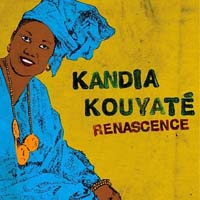
|
KANDIA KOUYATE
RENASCENCE (Stern's STCD1126)
The new Kandia Kouyaté album went straight to the top of Stern's new release charts, which is a sign that there is continued, even growing interest in Malian traditional music. Ever since Oumou Sangaré stormed into our consciousness in 1990 we have seen a steady flow of fine female praise-singers, from Nahawa Doumbia to Dienaba Diakité, to Sabré Soumano, Sali Sidibe, Coumba Sidibe, and that's only a few of the myriad performers. A lot of attention went into this fine production: there's a variety of instruments and styles behind Kouyaté. When still only 20 she gave a private recital that circulated on cassette causing her reputation to precede her, followed by gifts of cash, gold and even new cars -- one enthusiast put a private jet at her disposal. I am assuming that her patrons get more than a thrill from hearing her voice, maybe they attach some spiritual significance to getting a namecheck in her song. Despite touring to Europe and the USA she was still not well known because she refused to record and was only known to insiders via bootleg cassettes of her live performances. Things changed when she was invited to sing on Sekouba "Bambino" Diabaté's 1997 album Kassa (Stern's). However, after a few early recordings for Ibrahim Sylla, released by Stern's, she suffered a stroke. She did not sing or even speak for seven years, but, at the end of his life, Sylla persuaded her to return to the studio in 2011 and create this album which took four years to come to fruition. The backing is mostly acoustic, with balafon, kora and guitars. Her song about ill-health, "Sadjouhoulé," can be seen here.
|
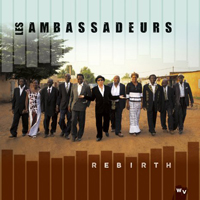 | LES AMBASSADEURS
REBIRTH (World Village)
A new release from Les Ambassadeurs is cause for celebration. They evolved from other supergroups in Mali "back in the day"-- the mid-70s -- and subsequently went their own ways in the mid-80s. In the late 70s they were the trendsetters, swinging from James Brown funk grooves to Cuban cha-chas but always keeping their folklore in mind, particularly in the vocal styles. Notably from their ranks, Salif Keita moved to Paris and international fame. Cheikh Tidiani Seck was another member with a solid musical career, known today for producing the exceptional Hank Jones meets the Mandinkas album, Sarala. Most of them continued in music and when they ease into a brief set of their hits, it's a joy as rich familiar sounds emanate from the virtual grooves. "Mali denou" was a 1977 track on Les Ambassadeurs vol 1 from Sonafric and also kicked off CD2 of Stern's indispensable box set. "Tiecolomba Hé (Hoodlums)" from vol 2 was also on the Stern's compilation and had Idrissa Soumaro singing, rather than Salif Keita. He is back, singing and playing organ. "4V" didn't make the cut for the Stern's collection, but you may have the original take on Mandjou which came out (in Europe) on Celluloid in 1978. It's a Manfila Kanté composition. He was the guitarist (originally from Guinée) and I am not sure he is still with us. (Guenter Gretz tracked him down for Kankan Blues and Back to Farabanah in 1987.) Guitar is played by Ousmane Kouyaté who rips out some amazing licks right from the get-go. He was one of three original guitarists (the third was Amadou Bagayogo, who now performs as Amadou and Mariam). Ever since Les Ambassadeurs' day Kouyaté has been Salif's right-hand musician. Sekou Diabaté is back on bass. "Seydou" appeared on a Badmos LP issued in Cote d'Ivoire in 1980 and was collected in France on a Universal Music compilation. These are new recordings, however they have lost none of the old magic: in fact, sonically they are wonderful, you can hear so much in them, every percussive nuance, and Salif still pours it on passionately. I am guessing a tour and further recordings are planned.
|
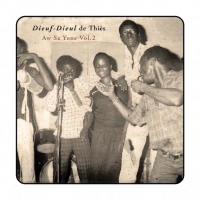
|
DIEUF-DIEUL DE THIES
AW SA YONE VOL 2 (Teranga Beat TBCD 020CD)
I've been revisiting my Senegalese collection since Cheikh Lo's latest release, as well as the Youssou Ndour concert from the 80s that came out in November 2015 on RealWorld. Now we have been inundated with great previously unreleased material from the bright days following independence from France in June 1960. From independence, Senegal thrived under Socialism with the visionary poet Léopold Senghor as president. The country never suffered a military coup or tribal wars and became a welcome venue for visiting acts from North America, Cuba and the rest of Africa, so the music scene thrived. Dieuf-Dieul embodied the local bands' ability to take external influences, such as Afro-Cuban and American jazz and psychedelic rock and incorporate them into their mbalax sound. But what's truly remarkable about them is that they were in many ways an urban legend, because they never released any recordings. Everyone from Thiès would say they were the best band ever, but no one had so much as a cassette to back up this claim. This makes their rediscovery by Adamantios Kafetzis of Teranga Beat even more remarkable: he has now given us two full-length albums by this fantastic group comprising all their known recordings. The band came about when a group of disaffected musicians from Ouza & ses Ouzettes (including the phenomenal guitarist Pape Seck) decided to quit (over money) while playing in Thiès and stayed in town to pick up gigs at local nightclubs. They were augmented by local singers and percussionists and combined the best elements of different musical backgrounds, traditional and modern, into a superb hybrid. They met Bassirou Sarr who was trying to get a band together and shared rehearsal space with him: his energy was infectious so they eventually merged the two groups. These tracks are mostly ten to twelve minutes long, with great guitar and sax solos and a warm earthy feel as they unfold into epic jams. The recordings were made live (I am guessing at Sangomar or another nightclub) in 1980 on a Sony four-track multi reel-to-reel recorder and there are also three tracks from an unfinished 1981 session. Bassirou Sarr is the featured singer (he has recently recorded with Africando) and he pours passion like lighter fluid onto the smoldering rhythm section of talking drums (sabar) and kit drums. Two other vocalists get one song each. In Casamance they met Assane Camara (then known as Camou Tande) and asked him to join the group. He does a Cuban number "Rumba para parejas," and Gora Mbaye (who had the lion's share of Volume 1) lends his strong griot tones to a traditional song in Wolof. In 1982, unable to get a recording deal, they broke up: some members joining Etoile 2000 and later hooking up with Baaba Maal. Pape Seck and the vocalists are still alive, so, like Baobab, there are murmurs of a reunion tour, which will be a wonderful thing to behold. |
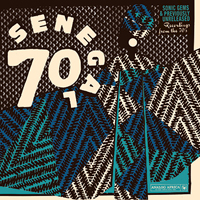
| SENEGAL 70:
SONIC GEMS & PREVIOUSLY UNRELEASED RECORDINGS FROM THE 70S (Analog Africa AACD 079CD)
When I and my ilk started collecting African music thirty years ago we never imagined that some treasures, long thought unattainable, would not only be discovered but made available to us. Back in the 1970s while a generation of now legendary bands were performing at the Sangomar nightclub in Dakar, the sound man/owner Moussa Diallo was rolling tape. Adamantios Kafetzis of Teranga Beat, who is devoted to uncovering the great rarities of Senegalese music, transferred these priceless tapes to digital and has identified over 300 songs. Now he has teamed up with Samy Ben Redjeb of Analog Africa to present some of the gems in a new compilation called Senegal 70. The mother of many of the bands of the 70s was the Star Band of Dakar, here fronted by Amara Touré (whose legendary 70s recordings came out on Analog Africa earlier this summer), performing the evergreen "El Carretero" (again in a version never heard before). From Star Band's ranks other groups emerged: Le Sahel, Orchestre Laye Thiam, No 1 de Dakar, Baobab, Dieuf Dieul de Thiès, and Xalam. And from that panoply Laye Thiam is represented with three (previously released) tracks, including "Kokorico" which is pure funk, with blues organ, sung partly in English. Baobab completists will be thrilled to discover two previously unreleased and sublime tracks from them, licensed from founder Thione Seck, captured live at the Sangomar nightclub. There is even room for an odd novelty number, "Viva Maravillas" by King N'gom & L'orchestre Perles Noires du Bénin: all I can say is you've probably never heard anything like it before (though at first it calls to mind "Hit the Road, Jack"), even if it is a cover of a Cuban original. It's Beninois salsa but flows well within the Senegalese mix. Le Tropical Jazz performing "Kiko Medina" is also outstanding. The album is a great mix and flows well. If you are mad at yourself for not getting Escale au Senegal or Latin thing before they went out of print, you have no excuse not to stock up on Senegalese oldies now.
|
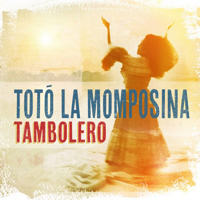 |
It's a great pleasure to write up this Totó la Momposina album because it is a reworking of her excellent debut La Candela Viva on the RealWorld label that compelled our attention 25 years ago. And it's not just the birth of a legend, it's the birth of two legends (because Batata is on there also). RealWorld are celebrating their anniversary by revisiting their catalogue and so far this has proved very fruitful. Totó, who is also about to celebrate an anniversary -- of 60 years as a performer, is a folklorist and scholar. From an early age she sang and danced in her mother's dance troupe, even as her native country Colombia was undergoing a civil war. Not only were the arts neglected but there was outright racism towards the African roots that she and her troupe were struggling to preserve. (She first heard of England in school when a charity delivered tins of hard cheese that she understood were a gift from the Queen of England!) When the WOMAD festival began in England Peter Gabriel, one of the organizers, had the idea of inviting selected acts down to his studio in rural Wiltshire to record a live album. Totó and her Tambores visited in 1991 and 1992 and laid down sets of Tambores, Sextetos and Gaitas, which are mostly vocal and percussion tracks. There are flutes (gaita) and even guitar and tiple (12-string guitar) on a couple of tracks. For the remixed album one track has been dropped and two added from the original master tapes. I compared the discs and it does sound richer. The liner notes say there was some overdubbing and choral additions by Totó's grand-daughters. Some of La Momposina's tunes have become classics, remixed by other bands, but also cherished as pure expressions of the blend of African, native and Spanish strains found uniquely in Colombia. The great international breakout sound known as Champeta began with Batata who was principal drummer in this group (heard on three tracks) before leaving to form his own Rumba Palenquera. "El Pescador" is a popular cumbia, composed by José Barros, that tells of the humble fisherman: "El pescador habla con la luna / habla con la playa / no tiene fortuna solo su atarraya (The fisherman speaks to the moon, he speaks to the beach, his fortune comes only from his net)." "La sombra negra (black shadows)" is a beautiful sextet with guitar and tiple that sounds Cuban, which it is because runaway African slaves from Cuba brought the songs with them. They built palenques, which were fortified villages in the jungle. The song, written by "Batata" Paulino Salgado, urges you to run run from the black shadow. To my mind "Dos de Febrero" and "Malanga" which come up next are both classics. The latter is in fact a remake of "Anabacoa" which was a hit for Perez Prado and Beny More back in their day. Batata is beating the daylights out of his tambor on the latter. The album ends with two sacred songs from the palenques, passed down to Batata by his father, also a master drummer.
|
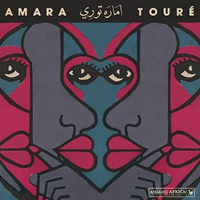 | AMARA TOURE
1973-80 (ANALOG AFRICA NO 18)
Samy of Analog Africa has taken his foot off the African Funk pedal and switched to a mellower sound, Salsa Africana, the griot appropriation of Latin beats as manifest in Senegal by bands like L'Etoile de Dakar and Star Band. This is definitely a good sign, though the Teranga Beat label has that area of music well in hand. But more is always merrier. Amara Touré is not a household name but had a number of hits in West Africa in the 1970s. Hailing from Guinea-Conakry he started out in Tropical Jazz of Dakar and was a founding member of the Star Band, as a percussionist. He also sang lead on some of their Cuban covers, with a distinctive raspy delivery. He then joined saxophonist Dexter Johnson's Super Star de Dakar (see DakarSound DKS16 and 17). After a decade in Dakar he headed to Cameroun and formed the Black and White Ensemble. A scratchy copy of their "Lamento Cubano" is one of my favorite Latin remakes of this era (teamed up with the other two 45s which have been posted on various blogs over the years). The 45s Touré released with this band form the first six cuts on this compilation, so I am pleased to get a better sounding copy but also to fill out the set because Samy went another mile and found the later work of this enigmatic musician. Touré went on to join Orchestre Massako of Mack Joss in Libreville, Gabon, in 1980 and cut an album with them (released on the Sonafric label), also included here in its entirety. The review copy had no information as to personnel. There is a superb guitarist and also a sultry sax, who is on a par with Dexter Johnson. This is fantastic music and deserves the wider audience new exposure will bring to it. While I am not opposed to bloggers posting music, they rarely clean up the sound or provide informative context. (I am not including Worldservice in this generalization, they have in fact offered some great notes on Amara on their post of his LP, now superannuated, which forms half of this new release.) We should patronize Analog Africa and keep them (i.e. Samy) out in the field doing this exemplary work.
|
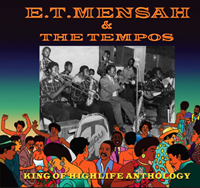 |
E. T. MENSAH & THE TEMPOS
KING OF HIGHLIFE ANTHOLOGY (RetroAfric24CD)
I thought the RetroAfric label was moribund: it's been 8 years since their RyCo Jazz compilation, and a decade since they updated their website. When I saw this new compilation announced I thought they were just repackaging their first two CDs which were devoted to E.T. Mensah: All for You (Retro 1CD 1986) and Day By Day (Retro 3CD 1991). While the music was good on those issues, the monochrome covers were uninspired. The last twenty-five years have seen major changes in the way music is delivered but the sound quality has not necessarily improved and one thing that now makes some labels stand out is their packaging and attention to detail (Analog Africa and Planet Ilunga come to mind). So I was pleasantly surprised to find this new package is a legible 64-page book with an nifty accordion insert at the back to hold 4 CDs. Mensah's career began in the 78 era (which had a long run in Africa), and extended into the EP and LP age. John Collins, the pre-eminent authority on Highlife music, wrote the booklet: it is the result of many days of interviews with Mensah and other musicans, conducted in 1974, and makes this the definitive work on Mensah as well as the cornerstone of any Highlife collection. But in addition to dance-band Highlife, Mensah recorded many calypsos in the 50s and 60s, as well as occasional forays into rhumba or samba. 'The Tree and the Monkey" shows the versatility of the band as well as the reach of styles here: it's a calypso sung by Juliana Okine, one of the first female vocalists on the Gold Coast; there is bongo and clave percussion and the accompaniment features muted trumpet (Mensah himself) and sprightly clarinet with a strong baritone sax solo. The "Tea Samba," another calypso, also in English, appeals strongly to me: it almost sounds like it was written as a commercial for the tea board. The guitar is in 50s jazz mode, with single string plucking. The singing is also uncomplicated: "It's refreshing as can be, you can make it easily. Hey mama, pour me out another cup of tea!" I like the English songs because they are most memorable to me. "School girl," "Because of money," "Don't mind your wife," and many others pop out insistently. But the instrumentals are equally compelling and show affinities to American jazz in the way the horns get a crack at a solo then join in unison for the chorus in the mostly under-3-minute tunes. "Mucho mambo" is one wonderful example. Their earliest recordings from 1952 are included and you will note how they leaned on imported music from other cultures, so we hear "Sly Mongoose" (first performed by Lionel Belasco of Trindad in the early 1900s) refigured as "All for You," and you will not be able to resist singing the Beach Boys' lyrics to "Sloop John B." Of course the opposite happened when Louis Armstrong came to town in 1956. Armstrong thought "All for You" was an old creole melody from Lousiana, whereas the locals argued it was an older Gold Coast melody that had gone to the new world with the slaves. The fascinating book tells the tale of break-ups, which seemed to happen with frightening regularity but somehow Mensah always managed to pull it together with new recruits. The untold story is that he was probably a tyrant or kept more than his share of the proceeds or else his band would have been happy to have the regular gig and acclaim. However this proving ground led to many other early pioneers of highlife setting up their own bands: King Bruce, Guy Warren and Saka Acquaye among the first. Subsequent bands left to form the Rhythm Aces and the Stargazers. Whenever he was on tour, it seems, sneaky club owners stole his musicians and tried to recreate his sound without him. However he toured to Nigeria regularly because it was lucrative and his music was greatly appreciated, to the extent that Nigerians soon began to develop their own form of Highlife. Rex Lawson and Victor Olaiyo both adapted Mensah's music to their own ends, with great results. Independence from Britain in 1957 should have been a great beginning, but had unfortunate consequences for Mensah. Inflation caused his club to falter, as beer prices rose 50%. He wrote a song celebrating the new era, "Ghana Freedom," and was summoned to the government offices. He thought he was going to hear praise for his contribution, instead Nkrumah was pissed off that other politicians were name-checked along with him. Decca had already pressed 10,000 copies of the disc. Mensah sent them a lengthy telegram explaining the situation and the engineers managed to remaster the disc with "politically approved" lyrics that only mention Nkrumah! This song is the germ of many highlife tunes that followed, both in structure and instrumentation. There is some appalling Spanish in "Señorita," however this is one of my favorite tracks. Described as a "congo," it packs a lot into three minutes. While it's nothing a Cuban would recognize, it has great feeling and segues into "Daavi Loloto," a "cara cara" sung in Ewe that picks up the tempo but is similarly propelled by a great bass riff. This time the trombone gets to trip out. Superb musicianship packs this set from front to back. You will hear why Mensah is truly the "King" of highlife.
|















